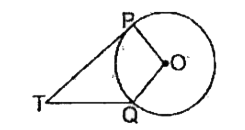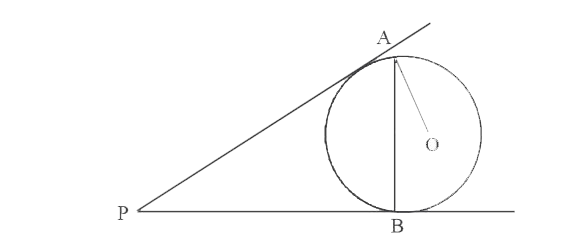Two tangents TP and TQ are drawn to a circle with centre O from an external point T . Prove that ∠PTQ=2∠OPQ .
To prove that ∠PTQ=2∠OPQ, we will follow these steps:
Step 1: Identify the given elements
We have a circle with center O and an external point T from which two tangents TP and TQ are drawn to the circle.
Step 2: Establish the right angles
Since TP and TQ are tangents to the circle at points P and Q, we know that:
∠OPT=90∘and∠OQT=90∘
This is because the radius at the point of tangency is perpendicular to the tangent line.
Step 3: Use the property of tangents
From the external point T, the lengths of the tangents to the circle are equal:
TP=TQ
This means that triangle TPQ is an isosceles triangle.
Step 4: Establish angles in triangle TPQ
In triangle TPQ, since TP=TQ, we have:
∠TPQ=∠TQP
Let us denote these angles as x. Therefore, we can write:
∠PTQ=x+x=2x
Step 5: Apply the triangle angle sum property
The sum of angles in triangle TPQ is 180∘:
∠PTQ+∠TPQ+∠TQP=180∘
Substituting the known angles, we have:
2x+x+x=180∘
This simplifies to:
2x+2x=180∘⟹4x=180∘⟹x=45∘
Thus, we find:
∠PTQ=2x=90∘
Step 6: Relate angles OPQ and PTQ
Now, consider triangle OPQ:
Since OP and OQ are radii of the circle, we have:
∠OPQ+∠OQP+∠POQ=180∘
Since ∠OPQ=∠OQP (both are equal as they are opposite the equal sides OP and OQ), let’s denote them as y:
y+y+∠POQ=180∘
Now, we know that:
∠POQ=90∘(as it is the angle subtended by the tangents)
Thus:
2y+90∘=180∘⟹2y=90∘⟹y=45∘
Therefore:
∠OPQ=45∘
Step 7: Final relationship
Now we can conclude:
∠PTQ=2×∠OPQ
Substituting the values we found:
90∘=2×45∘
Thus, we have proved that:
∠PTQ=2∠OPQ
We have a circle with center O and an external point T from which two tangents TP and TQ are drawn to the circle.
Since TP and TQ are tangents to the circle at points P and Q, we know that:
∠OPT=90∘and∠OQT=90∘
This is because the radius at the point of tangency is perpendicular to the tangent line.
From the external point T, the lengths of the tangents to the circle are equal:
TP=TQ
This means that triangle TPQ is an isosceles triangle.
In triangle TPQ, since TP=TQ, we have:
∠TPQ=∠TQP
Let us denote these angles as x. Therefore, we can write:
∠PTQ=x+x=2x
The sum of angles in triangle TPQ is 180∘:
∠PTQ+∠TPQ+∠TQP=180∘
Substituting the known angles, we have:
2x+x+x=180∘
This simplifies to:
2x+2x=180∘⟹4x=180∘⟹x=45∘
Thus, we find:
∠PTQ=2x=90∘
Now, consider triangle OPQ:
Since OP and OQ are radii of the circle, we have:
∠OPQ+∠OQP+∠POQ=180∘
Since ∠OPQ=∠OQP (both are equal as they are opposite the equal sides OP and OQ), let’s denote them as y:
y+y+∠POQ=180∘
Now, we know that:
∠POQ=90∘(as it is the angle subtended by the tangents)
Thus:
2y+90∘=180∘⟹2y=90∘⟹y=45∘
Therefore:
∠OPQ=45∘
Now we can conclude:
∠PTQ=2×∠OPQ
Substituting the values we found:
90∘=2×45∘
Thus, we have proved that:
∠PTQ=2∠OPQ
Topper's Solved these Questions
Similar Questions
Knowledge Check
Two tangents PA and PB are drawn to a circle with centre O from an external point P. If ∠OAB=30∘, then ∠APB is:
केंद्र O वाले वृत्त पर एक बाहरी बिंदु P से दो स्पर्श रेखाएँ PA तथा PB खींची जाती हैं | यदि ∠OAB=30∘ है, तो ∠APB का मान क्या होगा ?A15∘B30∘C120∘D60∘TP and TQ are tangents from T to the circle with centre O. Then is it possible to draw a circle through the points P, O, Q and T ?
 ANoBYesCCannot sayDData insufficient
ANoBYesCCannot sayDData insufficient
Two circles touch externally at a point P . From a point T on the tangent at P , tangents TQ and TR are drawn to the circles with points of contact Q and R respectively. Prove that TQ=TR . (FIGURE)
View SolutionFrom an external point P, two tangents PAandPB are drawn to the circle with centre O. Prove that OP is the perpendicular bisector of AB.
View SolutionIn the given figure, O is the centre of the circle and TP is the tangent to the circle from an external point T. If ∠PBT=30∘, prove that BA:AT =2:1
View SolutionIn Fig, PQ is a tangent from an external point P to a circle with centre O and OP cuts the circle at T and QOR is a diameter. If ∠POR=130∘ and S is a point on the circle, find ∠1+∠2.
View SolutionFrom any point P tangents of length t1 and t2 are drawn to two circles with centre A,B and if PN is the perpendicular from P to the radical axis and t21-t22=K.PN⋅AB then K=
View SolutionIf angle between two tangents drawn from a point P to a circle of radius 'a' and the centre O is 90∘ then prove that OP=√a
View Solution

